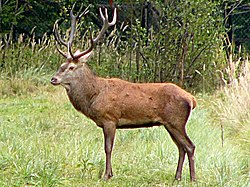| Central European red deer | |
|---|---|
 | |
| Scientific classification | |
| Domain: | Eukaryota |
| Kingdom: | Animalia |
| Phylum: | Chordata |
| Class: | Mammalia |
| Order: | Artiodactyla |
| Family: | Cervidae |
| Genus: | Cervus |
| Species: | |
| Subspecies: | C. e. hippelaphus |
| Trinomial name | |
| Cervus elaphus hippelaphus Erxleben, 1777 | |
The Central European red deer or common red deer (Cervus elaphus hippelaphus) is a subspecies of red deer native to central Europe. [1] The deer's habitat ranges from France, Switzerland, Austria, Germany, and Denmark to the western Carpathians. It was introduced to New Zealand, Australia, Chile, and Argentina.